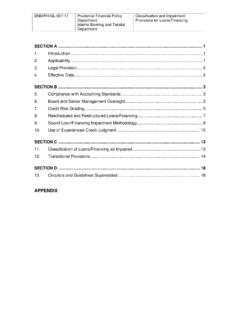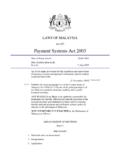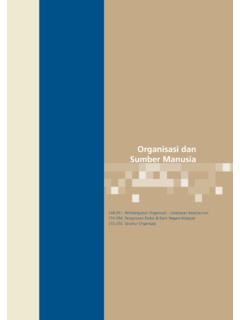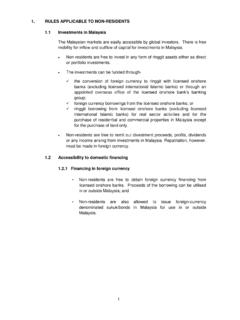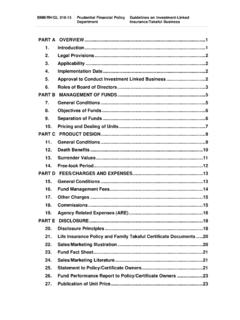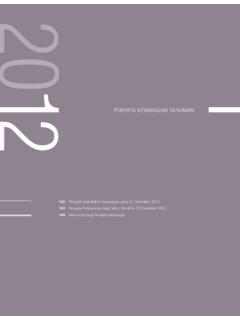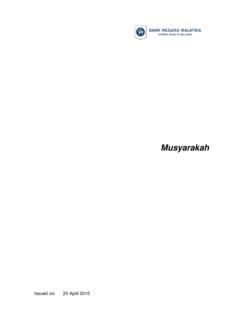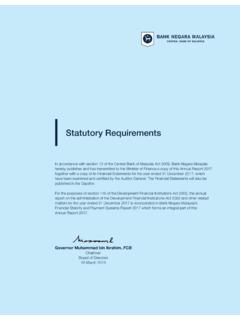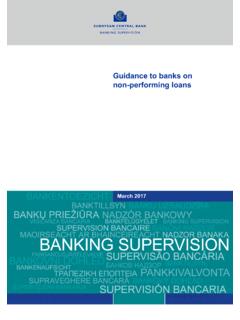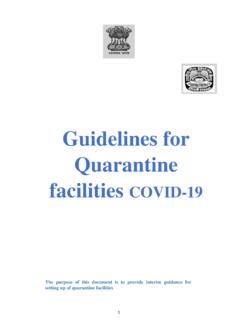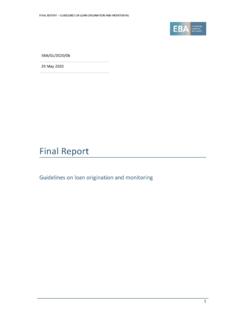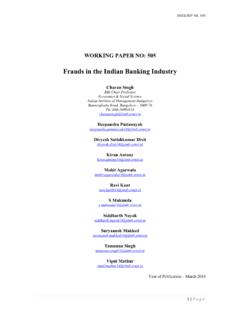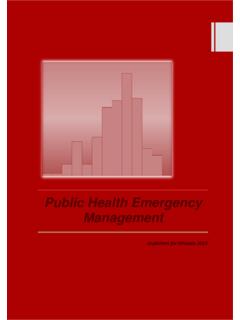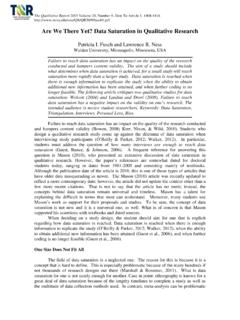Transcription of Recovery Planning - bnm.gov.my
1 Issued on 28 July 2021 BNM/RH/PD 029-47 Recovery Planning Applicable to: 1. Financial holding companies 2. Licensed banks 3. Licensed Islamic banks 4. Licensed investment banksRecovery Planning Issued 28 July 2021 TABLE OF CONTENTS GLOSSARY .. 1 PART A OVERVIEW .. 4 1 Introduction .. 4 2 Applicability .. 5 3 Legal provisions .. 5 4 Effective date .. 6 5 Interpretation .. 6 6 Related legal instruments and policy documents .. 8 PART B POLICY REQUIREMENTS .. 9 7 Level of application .. 9 8 General requirements .. 9 9 Reporting requirements .. 11 10 Executive summary of Recovery plan .. 11 11 Strategic analysis .. 12 12 Governance structure and oversight.
2 20 13 Recovery indicators .. 22 14 Recovery options .. 24 15 Scenario analysis .. 29 16 Communication and disclosure plan .. 33 17 Preparatory measures .. 34 18 Periodic reviews .. 34 APPENDICES .. 35 APPENDIX 1 List of reporting templates .. 35 APPENDIX 2 Information on business models and core business lines .. 36 APPENDIX 3 List of potential critical functions .. 37 APPENDIX 4 List of potential operational services .. 38 APPENDIX 5 Information on critical functions and critical shared services .. 39 APPENDIX 6 Information on governance .. 40 APPENDIX 7 List of potential Recovery indicators .. 41 APPENDIX 8 List of potential Recovery options .. 43 APPENDIX 9 Information on each Recovery option .. 44 APPENDIX 10 Information on scenario design and scenario analysis .. 45 Recovery Planning Issued 28 July 2021 GLOSSARY BAU Business-as-usual FHC Financial holding company FMI Financial market infrastructure FSA Financial Services Act 2013 GDP Gross domestic product IFSA Islamic Financial Services Act 2013 PIDM Perbadanan Insurans Deposit Malaysia RRP Recovery and resolution Planning SE Significant entities SME Small and medium enterprises Recovery Planning 4 of 45 Issued 28 July 2021 PART A OVERVIEW 1 Introduction The Bank, in collaboration with Perbadanan Insurans Deposit Malaysia (PIDM), has established a policy framework to implement Recovery and resolution Planning (RRP)
3 For financial institutions in Malaysia, in line with the Financial Stability Board s Key Attributes of Effective Resolution Regimes for Financial Institutions ( Key Attributes ). The RRP framework seeks to put in place an effective and efficient process to enhance supervisability, recoverability and resolvability of financial institutions, by incorporating essential elements of Key Attribute 11 of the Key Attributes into the domestic regulatory, supervisory and resolution regimes. The RRP framework aims to (a) facilitate the preparation and maintenance of robust Recovery plans by financial institutions which serve as a strategic Planning tool that (i) integrates with the risk appetite framework1 and reinforces risk management functions; and (ii) strengthens incentives to establish private-sector arrangements to recover from a wide range of stress events; (b) enhance capacity and preparedness of supervisory authorities to (i) facilitate ex ante changes to financial institutions business structure and operations to improve group-wide supervisability and recoverability; (ii) support the smooth execution of Recovery plans.
4 (iii) inform calibration of timely intervention and resolution actions should Recovery options be inadequate to address viability threats; and (iv) support effective supervisory cooperation and crisis management arrangements with host and home authorities; (c) strengthen capacity and preparedness of resolution authorities2 to improve resolvability of financial institutions and operationalise feasible and credible resolution plans that (i) preserve continuity of critical functions to support the financial intermediation process, orderly market conditions and maintain public confidence in the financial system; (ii) promote resolution strategies that minimise risks of loss to public funds and costs to the financial system, destruction of franchise value and moral hazard; and (iii) provide for procedural/legal clarity to ensure orderly resolution in home and host jurisdictions.
5 1 This refers to the risk appetite framework as described in the Risk Governance policy document and the Financial Stability Board s Principles for an Effective Risk Appetite Framework. 2 In respect of banking institutions, PIDM is the resolution authority of licensed banks and licensed Islamic banks. The Bank is the resolution authority for licensed investment banks. Recovery Planning 5 of 45 Issued 28 July 2021 This policy document sets out key principles, requirements and supervisory expectations on the development and maintenance of Recovery plans. A Recovery plan is an overarching playbook that is developed, maintained, and when necessary, executed by a financial institution to manage severe stress events that threaten to undermine the financial institution s viability.
6 As part of Recovery Planning , financial institutions are to identify and plan for the execution of a suite of Recovery options to restore long-term viability under a range of idiosyncratic and system-wide stress events. It should not take into account the possibility of policy intervention by authorities, or access to any exceptional financial support from public funds. The Bank expects Recovery Planning to be an iterative and evolving process, with financial institutions reviewing their Recovery plan on an ongoing basis. To supplement this, the Bank will continuously engage with financial institutions to clarify the Bank s expectations on Recovery Planning as part of ongoing supervision. In the extreme event that a financial institution has no reasonable prospect for Recovery ( the institution is likely to become non-viable and implementation of Recovery options is not feasible or has proven to be ineffective), a resolution plan would be deployed by the resolution authority to ensure that the financial institution is resolved in an orderly manner, a manner that mitigates the impact on financial stability and minimises losses to public funds.
7 Resolution Planning seeks to facilitate the effective use of available resolution powers by enabling resolution authorities to identify in advance a feasible and credible resolution strategy for each financial institution and an operational plan for its implementation. To achieve this, the information and assessment contained in the Recovery plans will serve as an important starting point for resolution authorities3 to- (a) determine a preferred resolution strategy that is tailored to the specificities of each financial institution; and (b) conduct a resolvability assessment. 2 Applicability This policy document is applicable to financial institutions as defined in paragraph 3 Legal provisions This policy document is issued pursuant to (a) sections 47(1), 143(1) and 266 of the Financial Services Act 2013 (FSA); and (b) sections 57(1), 155(1) and 277 of the Islamic Financial Services Act 2013 (IFSA).
8 3 Further guidance on resolution Planning for licensed banks and licensed Islamic banks will be issued by PIDM. Recovery Planning 6 of 45 Issued 28 July 2021 4 Effective date This policy document comes into effect on 28 July 2021. 5 Interpretation The terms and expressions used in this policy document shall have the same meanings assigned to them in the FSA and IFSA, as the case may be, unless otherwise defined in this policy document. For the purpose of this policy document S denotes a standard, an obligation, a requirement, specification, direction, condition and any interpretative, supplemental and transitional provisions that must be complied with. Non-compliance may result in enforcement action; G denotes guidance which may consist of statements or information intended to promote common understanding and advice or recommendations that are encouraged to be adopted; banking institution refers to a licensed bank, a licensed Islamic bank, and a licensed investment bank, collectively referred to as financial institution(s) ; board refers to the board of directors of a financial institution; core business lines refers to business lines that are significant to a financial institution as described in paragraphs and ; covered entities refers to a financial institution and its financial and non-financial subsidiaries, including insurance or takaful subsidiaries as set out in paragraph.
9 Early warning phase refers to a phase when one or more early warning thresholds have been breached and a decision has been made by a financial institution to intensify monitoring or prepare to implement appropriate Recovery options; early warning threshold refers to the threshold set for a Recovery indicator that would alert/or prompt a financial institution of its deteriorating financial position. A breach of this threshold may form the basis for intensified monitoring or preparation to implement appropriate Recovery options; financial group refers to a group of related corporations under a financial holding company or banking institution, as defined in the FSA and IFSA; FHC refers to a financial holding company approved by the Bank under section 112(3) of the FSA or section 124(3) of the IFSA; financial institution refers to a FHC, a licensed bank, a licensed Islamic bank, and a licensed investment bank, as the case may be.
10 Recovery Planning 7 of 45 Issued 28 July 2021 financial subsidiary refers to any entity, whether incorporated in or outside Malaysia, engaged predominantly in, or acquiring holdings in other entities engaged predominantly in, any of the following activities: banking, insurance, takaful, provision of credit, securities broking, fund management, asset management, leasing, and factoring and similar activities that are in connection with or for the purposes of the conduct of these activities; Islamic entity refers to the following: i. a licensed Islamic bank, or a licensed takaful operator, or ii. a licensed bank or licensed investment bank to which the Bank has granted its written approval under section 15(1)(a) of the FSA to carry on Islamic banking business; operational service refers to a service, activity or operation which does not generate direct revenue for a financial institution, but supports other revenue-generating business activities of that financial institution; preferred Recovery strategy outlines a combination or sequence of feasible Recovery options that a financial institution deems to be the most credible and effective to address a specific stress scenario developed for its Recovery plan.
